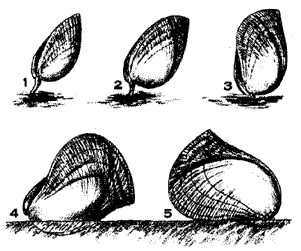
| Palaeos: |  |
Rhynchonelliformea |
| Brachiopoda | Atrypida |
| Page Back | Page Up | Unit Home | Metazoa |
| Page Next | Page Down | Dendrogram | Glossary |

The Atrypids are the first of the spiral-lophophorate brachiopods to appear. Originally included under the order Spiriferida, they are now known to have developed the characteristic spiral lophophore independently.
Atrypids have a short hinge line, inconspicuous beak, and very inconspicuous interarea on the pedicle valve. All have a rounded outline. In longitudinal profile (below), the shells range from biconvex, which is the most common, to convexi-plane, plano-convex, and concavoconvex.
| image to be added |  |
 |
|
|
|
|
|
|
A small minority of the Atrypacea have smooth shells, others being rather finely costate or having medium to coarse plications. Some possess wide "wings," or alate lamellae, while in other species the lamellae fold into delicate spines. Concentric growth lines or lamellar outgrowths of shell distinguish some genera, such as Atrypa.
Internally, the posterior part of the pedicle valve generally bears large muscle scars. Several genera have well-developed dental lamellae, whereas others lack these structures. A distinguishing feature of the Atrypacea is the manner in which the beginnings of the spiralia bend outward so as to enclose between them the remainder of the spiral cones.
Ordovician Atrypids are moderately small biconvex shells having fine radial plications and an inconspicuous interarea on the pedicle valve. The spiral lophophore is directed inward, with the crossbar (jugum) connecting the outermost coil of the spires being located posteriorly in some and variably in others.

Atrypa reticularis Devonian Clark County, Indiana, USA. Matrix free silicified specimen measuring 2.8 cm across |
The Silurian was characterized
by smooth-shelled Atrypacea in which the spires inside the
outermost loop are pointed outward or turned at right angles toward the
floor of the brachial valve, as in Atrypa. Various species
of Atrypa are the most common representatives of the Atrypacea during the
Devonian. Most
have fine costate ornament, but some have coarse ribs crossed by rough
lamellae.
The Atrypids were among the many invertebrate groups wiped out by the Frasnian-Famennian mass-extinction. |
On the left is the classification according to the Treatise
on Invertebrate Paleontology. On the right is the newer classification
by ![]() EuroBrachNet.
EuroBrachNet.
|
|
|
| Atrypidina
Atrypacea (Middle Ordovician-Late Devonian) Dayiacea (Middle Ordovician-Early Devonian) |
ATRYPIDA
Zygospiridina Zygespiroidea (?Early Ordovician-Middle Silurian) Atrypidina Atrypoidea (Late Ordovician--Late Devonian) Lissatrypidina Lissatrypoidea (?Middle Ordovician-Late Devonian) Davidsoniidina Davidsonioidea (Late Silurian-Early Devonian) Palaferelloidea (Early Devonian) |
RADIATIONS AND EXTINCTIONS OF ATRYPID BRACHIOPODS: ORDOVICIAN-DEVONIAN
Paul Copper
"Atrypid brachiopods originated during the late Llanvirn (Llandeilo) [Darriwilian -- ed.] benthic 'shelly' radiation, and the last taxa disappeared towards the Frasnian-Famennian extinction boundary, so that the order endured for close to 100Ma, commonly numerically dominating many other brachiopods in shallow water communities. All species are known to have been exclusively tropical, and preferentially subtidal carbonate shelf and ramp inhabitants: more than 200 genera and subgenera have been described. Using the latest generic diversity compilation at the stage level, including synonymies, the Caradoc (11 genera) and Hirnantian (9) mark a slow rise and arrival of the major suborders and families. The 'Zygospira group' (Anazygidina), which dominated prior to the Ordovician / Silurian boundary , i.e. Hirnantian, mass extinction events, were taken over by the 'Atrypa group' (Atrypidina) in the latest Ordovician. By the late Llandovery (Telychian), 32 genera proliferated, including many smooth-shelled taxa (Lissatrypidina), the largest expansion of the Atrypida during their history, a diversity maintained to the end of the Ludlow-Pridoli. The Early Devonian (Lochkovian) saw a decline to 20 genera, with a slow return by the end of the Pragian, a tectonically active phase marked by global sea level drawdowns, and provinciality. The late Emsian-Eifelian marked a peak in atrypoid diversity, reaching a maximum of 41 genera, coinciding with a global greenhouse setting and reef expansion, with many taxa specifically adapted to and confined to reefal carbonates. Diversity declined in the mid-Givetian, and was reduced by 50% towards the end-Givetian, with dramatic losses of reefal taxa, many at the family level. The Frasnian was a stage of low diversity (12 genera), though there was local high abundance especially in mid-Frasnian time, up to the Palmatolepis rhenana conodont zone: long-lived, cosmopolitan taxa dominated, with some new arrivals within the family Atrypidae. Within the latest Frasnian P. triangularis Zone, most regions saw fewer than two or three genera prevailing: there are no mass 'death horizons' known, and declines were stepdown events, probably tied in to sea level oscillations (T/R cycles), with virtual absence of atrypids in the uppermost meters of strata with a complete F/F succession. There are no Atrypida known from the Famennian, except as reworked Frasnian shells, thus a long-lived and highly successful group came to an end."from The Fourth, Millennium, International Brachiopod Congress

Brachiopoda main page |